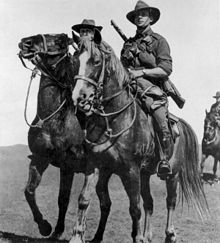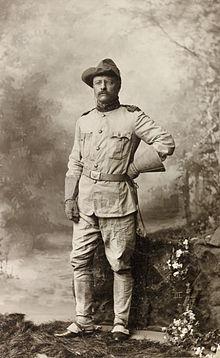Slouch hat
The slouch hat (sometimes also a cavalier hat) is a felt hat with a wide brim that is characteristically turned up in one or more places.
history
The slouch hat was part of the costume during the Thirty Years' War ; In Europe at this time a military style of clothing was widespread, which also included this particular hat shape. The hat could be decorated with one or more feathers.
At the beginning of the 16th century the beret prevailed , but by 1550 the hat became fashionable again, first as a high, stiffened Spanish hat, then as the Dutch so-called Rubens hat. Soon after the beginning of the 17th century, the Swedish slouch hat emerged, which replaced almost all other headgear. The design in line with contemporary tastes sometimes made the slouch hat an expensive, prestigious item. Towards the end of the 17th century and the beginning of the 18th century, the hat was replaced by the related tricorn as the hat of the military and bourgeoisie. In the course of the 19th century, the slouch hat experienced a renaissance and was used in various armies around the world as a tropical or all-weather hat.
Australia
The slouch hat (or slouch in English) is part of the traditional uniform of the Australian armed forces . The hat became the hat of the Victorian Mounted Rifles in 1885 after the hat had been worn by the Cape Mounted Rifles in South Africa for a long time. In 1890 he was taken over by the entire army, with the exception of the artillery. The use of the hat by Australian troops in the First and Second World War made him a national icon.
Germany
During the 1848 revolution, the Kalabreser was a slouch hat worn by revolutionaries like Friedrich Hecker . In the Schleswig-Holstein survey , volunteer corps members wore slouch hats.
After German unification and the acquisition of colonies, the hat became part of the uniform of the German protection forces . After the protection troops, the hat in Germany is often called the protection troop hat or, after the colony of German South West Africa, South West. The hat was also worn by German scouts.
Ireland
During the Easter Rising , members of the Irish Citizen Army wore floppy hats.
New Zealand
As in Australia, the floppy hat was introduced as an army hat in New Zealand. In New Zealand it is generally referred to as the Mounted Rifles Hat (MRH for short).
United States
In the USA, the slouch hat enjoyed a certain popularity among soldiers at least since the American Civil War . During the American-Spanish War , the Rough Riders , led by Theodore Roosevelt , wore floppy hats, among other things.
Others
The employees of a secret service are casually referred to as "floppy hats", especially when they are doing their job - covert operations at home and abroad. The background is the 19th / 20th Century real use of broad-brimmed hats by secret services, which were pulled deep into the face in order to make it as not recognizable as possible. Cartoonists like Harm Bengen use this image in their works, usually supplemented by sunglasses and a loden coat .
See also
literature
- Entry hat . In: Meyers Enzyklopädisches Lexikon . Bibliographisches Institut, Lexikonverlag, Mannheim / Vienna / Zurich 1975, Volume 12, p. 365.
- Erika Thiel: History of the Costume . 8th edition. Henschel-Verlag, Berlin 2004, ISBN 3-89487-260-8 , p. 213.
Web links
Individual evidence
- ↑ Planet Knowledge Hat Lexicon
- ↑ The Slouch Hat on the side of the Australian Army.
- ^ Jan Schlürmann: The German Volunteers of the 1st Schleswig War. An Overview of the Freikorps' Organization, Uniforms, Flags and Armament in 1848. In: Chakoten 62 (2007), No. 4, pp. 16-20.
- ^ Uniform of the New Zealand Mounted Rifles
- ^ Image of the Canterbury Mounted Rifles with floppy hats on NZ History.







